North Vietnam, 5th Anniversary of the Guerilla Fighter Mac The Bu o’i (Army Heroine), November 5th, 1956 (Michel Nr. 46-49); Women were an essential part of the war effort and fought side by side with men but often worked in logistics. So, it is not surprising that a female guerrilla fighter who was killed in 1951 was honored immediately after Tran Dang Ninh, whose stamps were issued in July of 1956. The nominals are very high and they appear to cater to international mail and larger domestic parcels. Given the high nominals not many stamps were collected in the 1950’s which explains the much higher prices this set is valued at as compared to other sets from the period. Also the numbers printed must have been lower as the high denomination set of the “Return of the Government”, as no mint sheets remained in the postal archives. So the market distortions, that happened due to late Cotevina sales on other early sets, did not occur for this set and it remains very scarce in mint condition. Catalogue values of €700 (Michel) or $650 (Scott) are excessive though. It usually sells for around $400 on E-Bay in mint condition, higher if the quality is exceptional.
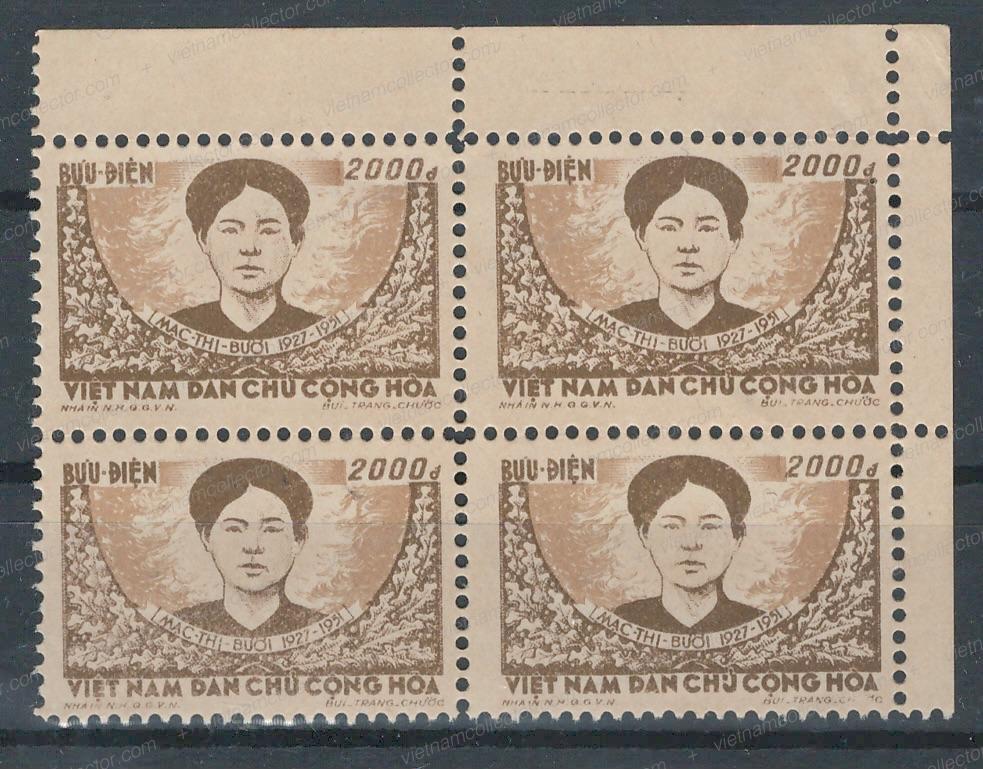
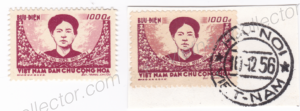
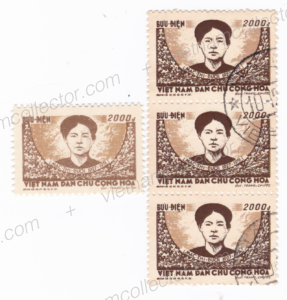
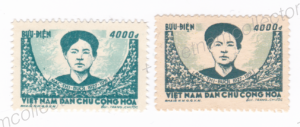

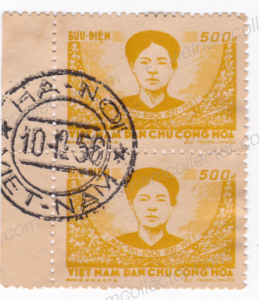
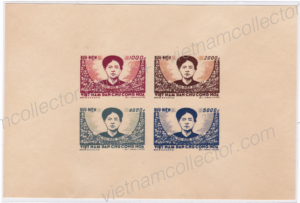
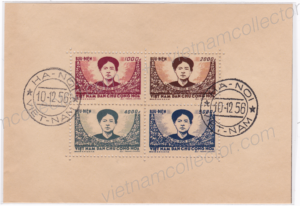

Your are most likely to encounter a used set in the form of cancelled to order specimens. These are much more available on stamp websites or auction houses but sellers often trick people in believing that a CTO set costs the same as postally used. So, they advertise the high Scott value for postal use samples and do not mention that Scott values a CTO set only at $100. Michel is again, off the mark, as its value of €50 for a the CTO version is a bit too low. Note that the 1,000D has the plate error “white spot on left side of hair” and the 5,000D value the plate error of “white spot on right side of hair”. Letters are very rare and only appear once in a blue moon on the market. The most likely value to found on cover is the 1,000D value as it basically almost covered the standard letter rate to Europe for a registered letter. Below is a registered letter sent by the commercial section of the Czechoslovakian Embassy to a company in Prague. It was mailed in December, 1956 or just a little over a month after the stamps were emitted and it carries one copy of the 1,000D value plus other early NVN stamps for a total postage of 1,190 Dong. Note that the 1,000D stamp has the plate errors of white spot in D of DIEM and white spot in right side of hair.
Letters are very rare and only appear once in a blue moon on the market. The most likely value to found on cover is the 1,000D value as it basically almost covered the standard letter rate to Europe for a registered letter. Below is a registered letter sent by the commercial section of the Czechoslovakian Embassy to a company in Prague. It was mailed in December, 1956 or just a little over a month after the stamps were emitted and it carries one copy of the 1,000D value plus other early NVN stamps for a total postage of 1,190 Dong. Note that the 1,000D stamp has the plate errors of white spot in D of DIEM and white spot in right side of hair.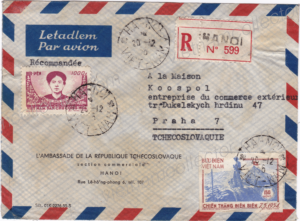
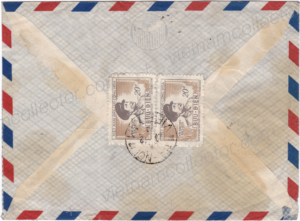
Here is a similar registered letter, also sent by the Czechoslovakian Embassy, mailed in January of 1957 and carrying one of the 1,000D Mac Thi Bu o’i stamps plus stamps from the Liberation of Hanoi, Bai Thu’o’ng dam and Tran Dang Ninh sets for an overall postage of 1,480D. Czech arrival cancel from February 4th, 1957.
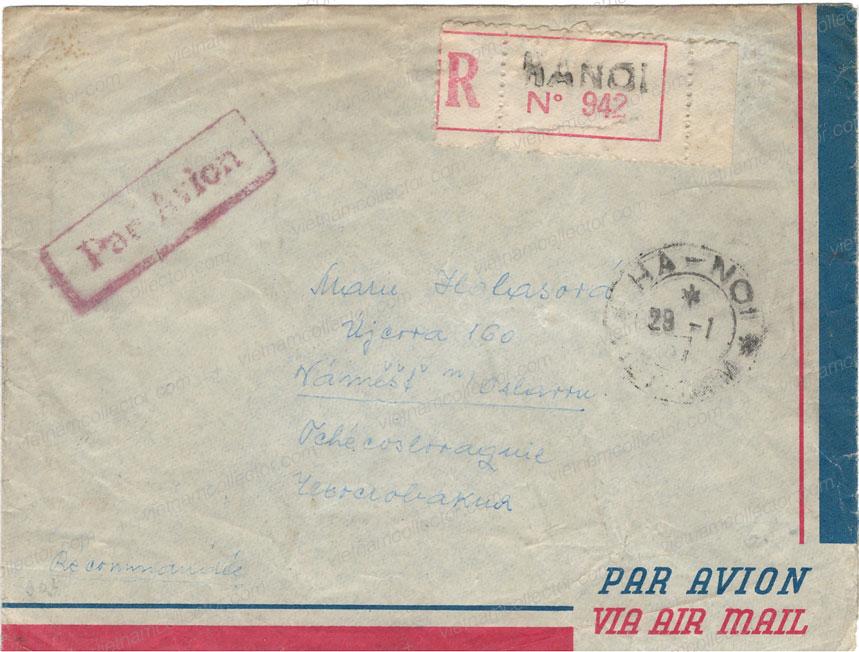
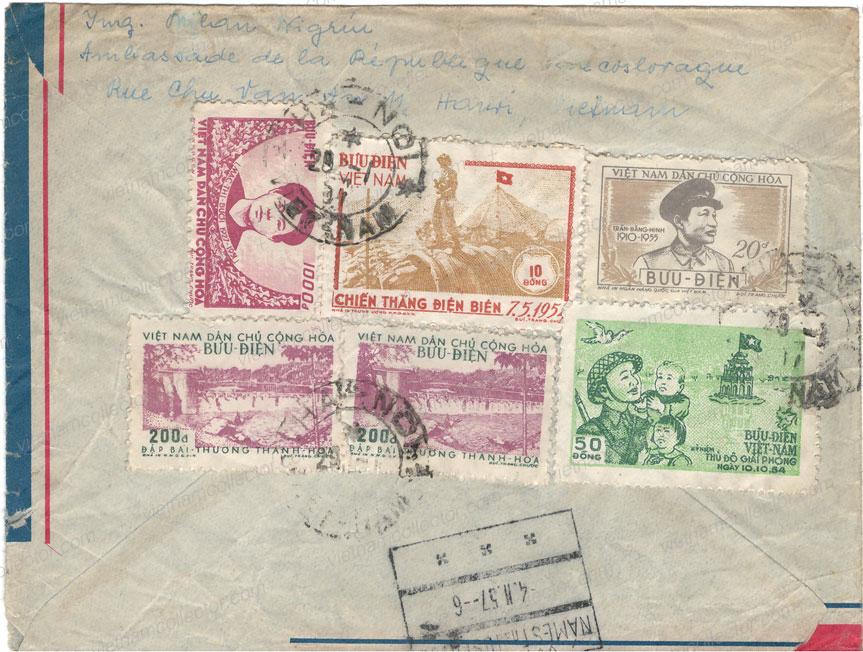
Here is a single franking of the 1,000D value sent from Hanoi in July of 1957 to a Chief Doctor at the Charite’ (the largest hospital in the former East Berlin). The 1,000D tariff is somewhat high for a letter that was not registered. The standard international surface rate at the time was 300D (up to 20 grams of weight) and 350D surcharge for air mail (for each 5 grams). The weight of the letter therefore was between 5 to 10 grams. 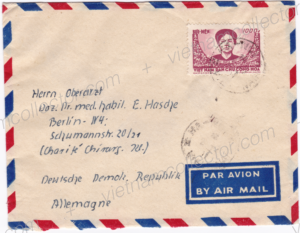
Another rare single franking of the 1,000D stamp on an international air mail letter sent from Hanoi to a high level doctor of the world famous Charite’ hospital in East Berlin in July of 1957.
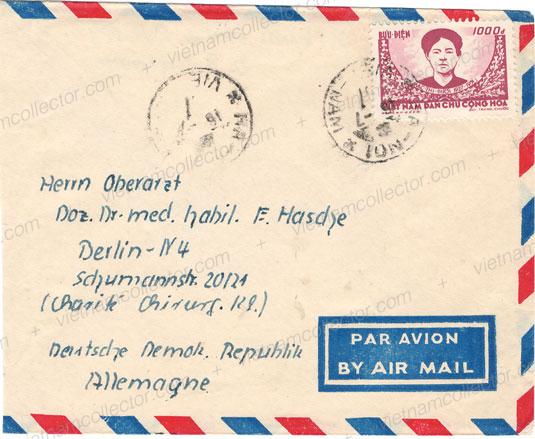
Very rare multiple franking of the 1,000D value (3) paying an overall postage of 3,000D on a registered international air mail letter sent from Hanoi to Czechoslovakia in May of 1957.
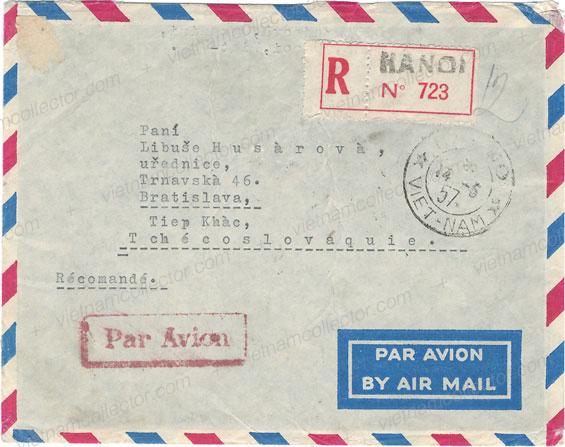
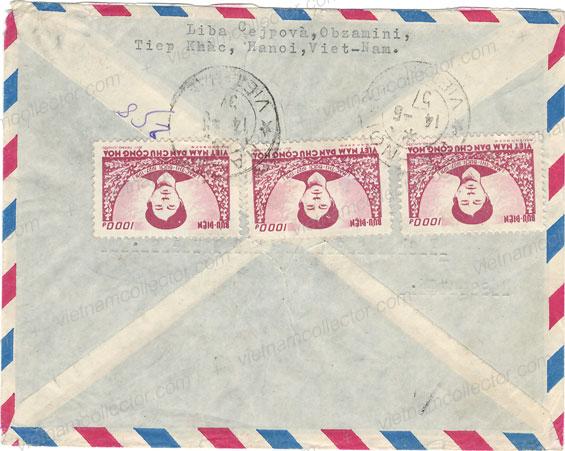
Below is a larger envelope from Hanoi in April of 1957 to a ministry in Prague, Czechoslovakia. It is franked with a strip of three of the 1,000D value plus another early NVN stamp for a total amount of 3,300 Dong. Most of these large envelopes either ended up in archives or were destroyed.Very rare!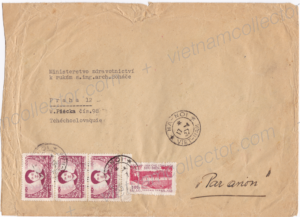
Very rare single franking of the 2,000D value from a member of the East German Embassy in Hanoi to a relative in East Germany. The 2,000D franking is, again, pretty high. With the surface rate to East Germany being at 300D (up to 20 grams) and the air mail surcharge at 350D (for every 5 grams) the letter must have weighed around 20 grams. 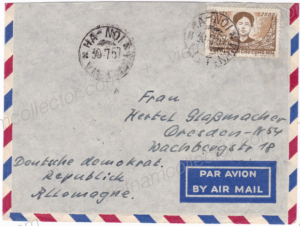
Very rare mixed franking sent by Xunhasaba using one of the 2,000D Mac Thi Bu o’i stamp plus one 1,000 Handicraft stamps for an overall postage of 3,000D. Green Dover custom cachet.
Very rare mixed ranking of the 2,000D Mac The Bu o’i stamps (2= together with the 3,000D Return of the Government and two 20D 12 Years Republic stamps paying an overall postage of 7,040D on a registered air mail letter sent from Hanoi to East Germany in December of 1957. At that time the international surface rate for the first 5g of weight to East Germany was 300D, the air mail surcharge 350D and the registration surcharge 600D. So, given the high postage, the letter must have been very heavy. This is evidenced by a green roll cancel that was applied upon receipt by the package station in Leipzig and that stated “No Contents Control”. Illegible German arrival cancel on the reverse.
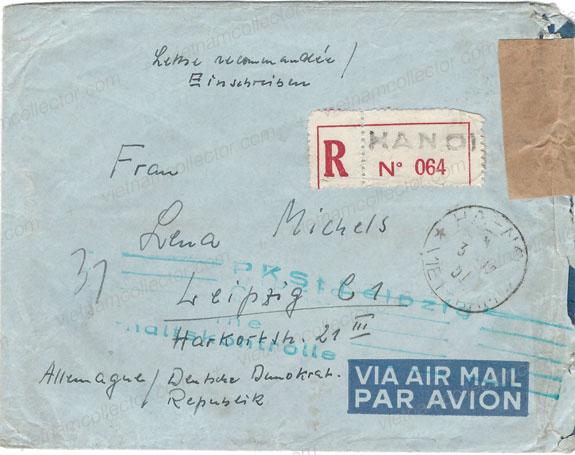
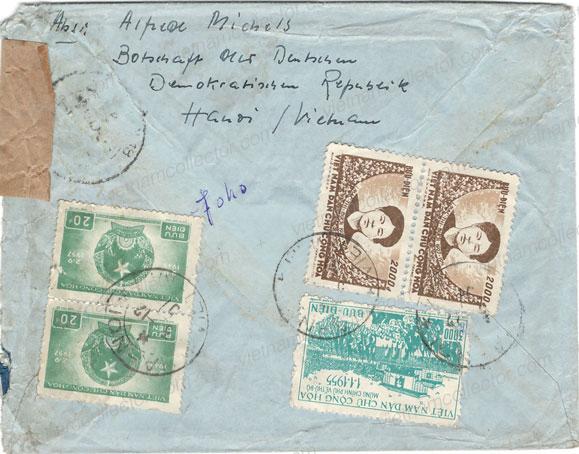
This letter most likely has philatelic origins. It is a local letter franked with a single 5,000D value. Since the standard local letter rate was a mere 100D this envelope was probably prepared for collectors. Nevertheless it is the only letter with a single franking of this stamp that the editor has ever seen. Note that the stamp has a significant passer-shift of the background color towards the top.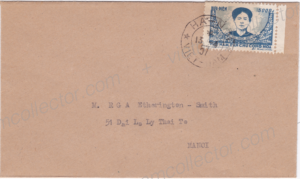
Postally used cover showing a very late usage of the 5,000 Dong stamp in 1973. The Old Dong was devalued on March 1st, 1959 by 1,000:1 which meant that the 5,000 Dong stamp was only worth 5 New Dong in 1973. The overall franking of this registered, express mail letter amounted to 5.16 New Dong (ex Klewitz). Note that the stamp has a significant passer-shift of the background color towards the top.
Registration Nr. 100037


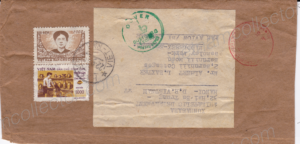
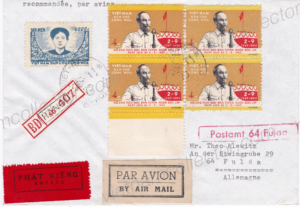

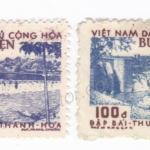


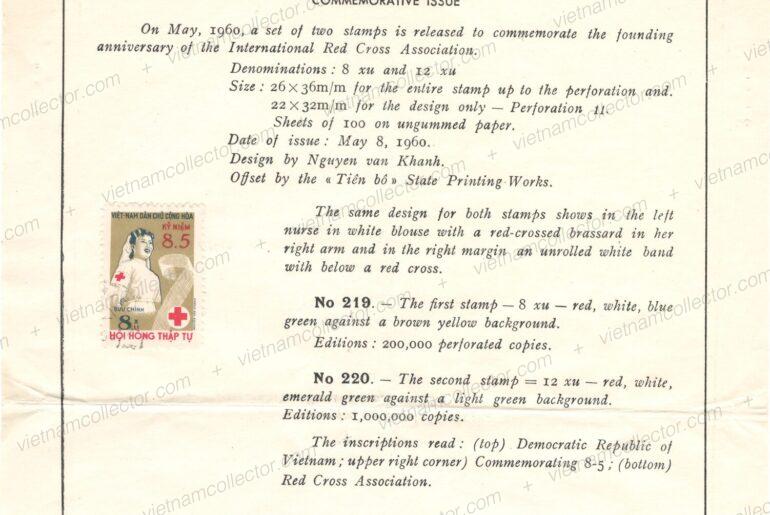
Comments are closed.